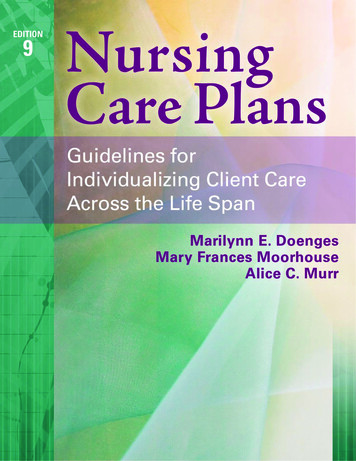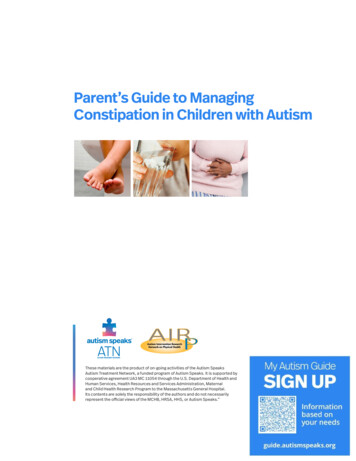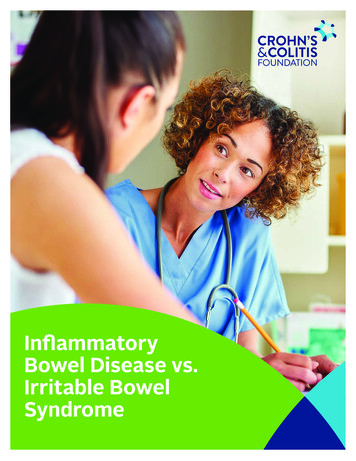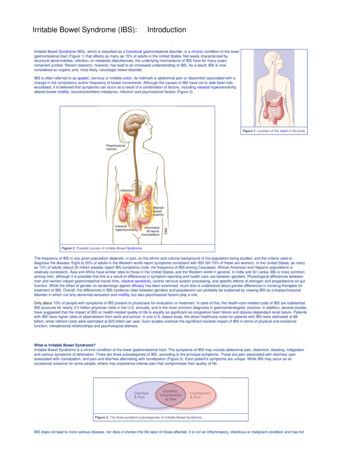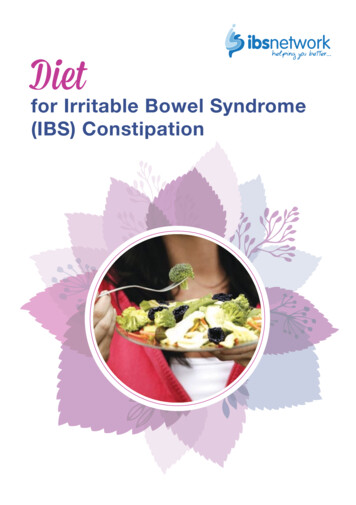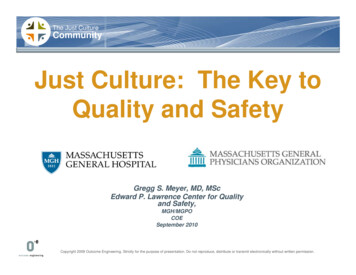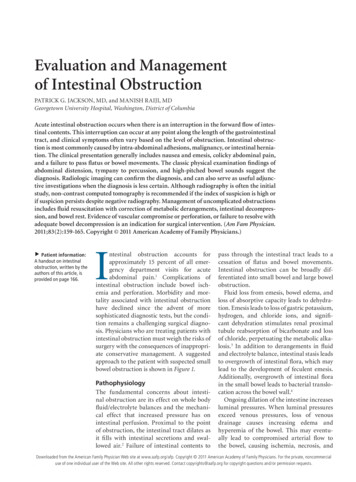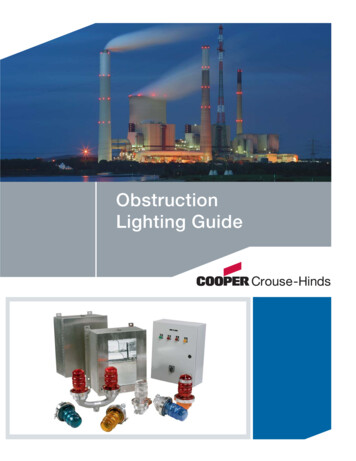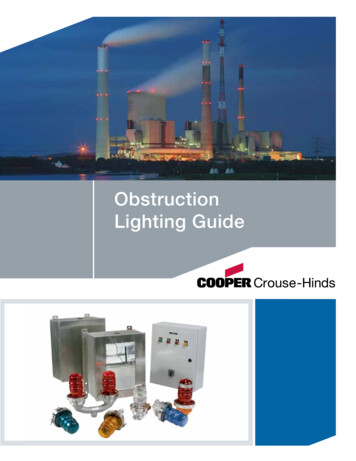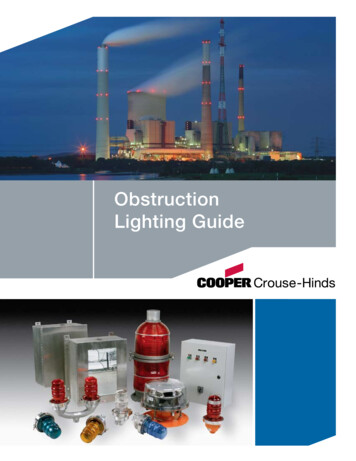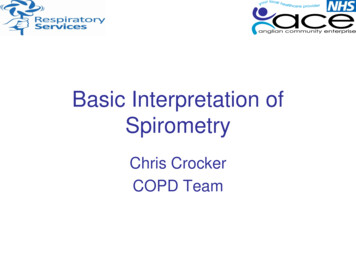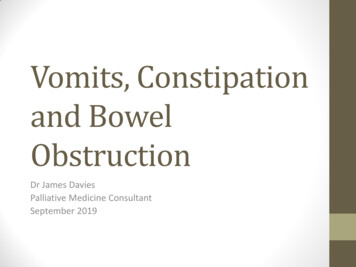
Transcription
Vomits, Constipationand BowelObstructionDr James DaviesPalliative Medicine ConsultantSeptember 2019
Objectives Assessment of vomiting Managing vomiting Constipation Bowel obstruction
Some terms Nausea and vomiting are distinct entities Nausea – the subjective feeling of the need to vomit or retch Vomiting (emesis) – oral expulsion of GI contents (active) Regurgitation – effortless passage of gastric contents into themouth Retching – muscular events of vomiting without the expulsionof vomitus Dyspepsia – epigastric burning, gnawing, bloating, pain
Case study 42 year old man Diagnosed with oesophageal cancer 4 months ago Started on oxycodone last week due to epigastric pain Presents with vomiting Initial thoughts?
S – out of his mouthO – very suddenly after lunch on SundayC – undigested foodR – no diarrhoeaA – pain got worse after eatingT – now after eating anything or drinking anythingE – Exacerbated by eating, nothing relievesS – feels dehydrated and unwell Thoughts now?
What makes people feelnauseated/vomit?
What makes people feelnauseated/vomit? Mechanical – bowel obstruction, gastric outlet obstruction, gastric paresis,constipation Movement – vertigo, travel sickness, BPPV Biochemical – electrolyte disturbance, altered pH (sepsis/resp failure/metabolicdisturbance), paraneoplastic effects Drugs – opioids, chemotherapy, dig toxicity, antibiotics, anaesthetics Infection – (sepsis, abx), GI specific infections Neoplasm – direct effects of tumours, paraneoplastic effects, effects oftreatment (chemo/XRT) Central causes – raised ICP, brain mets Psychological – anxiety and depression
History and Examination Can the symptom be explained? Need a systematic approach to elucidate the underlying cause This includes a good understanding of their presentingdiagnosis and current treatment Sometimes you might need further investigations e.g CT head,OGD Reverse the reversible
Understanding themechanisms
Common antiemeticsAntiemeticMoAWhen to useSide effectsDomperidoneD2 receptors instomachFor prokinesisConstipationParkinsonsProlong QTc –MHRA alertNo parenteralformulationMetoclopramideD2 peripherallyand centrally(stomach, CTZ,? VC)Prokinesis?Partial sness)Some QTc issuesWatch for colickyabdominal painCyclizineAnti-histamineH1 ed ICP due tometsSedatingConstipatingIV use – get a buzzAvoid concurrentuse with a prokineticOndansetron/Granisetron5HT-3 (CTZ)Chemotherapyrelated“Bowel irritation”ConstipationHaloperidolD2 centrally(CTZ and VC)Opioid induced,other druginducedBiochemicaldisturbanceSedationFalls riskParkinsonismSafe and effectivein low doses
What would we expect? An assessment as to the cause Consideration as to what is reversible A trial of an appropriate anti-emetic given by an appropriateroute (if acutely vomiting then needs IV or SC) If symptom poorly controlled/not settling/side effects tooburdensome seek Specialist Palliative Care advice
What will Sp Pall Care do? Re-assess the underlying cause and the potential forreversibility We may use other medications Olanzapine Levomepromazine Aprepitant/fosaprepitant (rarely) We may use other routes CSCI Transdermal patch
Constipation
Physiology Small bowel motility Segmentation to mix food(in response to a meal) Initiated by electrical activityfrom pacemaker cells Regulated by the myentericnervous system andautonomic nerves Some propagation Migrating motility complex Repeated waves of peristalticactivity every 90 mins Food residues spend around2 hours in the small intestines Peristalsis mediated by AChand VIP
Physiology Large bowel motility Slower and less frequent segmentations4-6 forward peristalsis “mass movements”2 peaks – one on waking, one after midday mealFood residues spend 18h-3 days in the large bowel
Physiology Fluid absorption Around 7 litres fluid produced by gastric, pancreatic, biliary andsalivary secretions on top of 1-2 litres of dietary fluids 75% reabsorbed in small intestine, most of the rest in the colon Fluid absorption via active sodium ion transport (Na /K ATPase)and subsequent osmosis
Defecation Distention of the wallof the rectum from amass movement offaecal matter leads todefaecation reflex Mediated bymechanoreceptors Rectal contraction,internal anal sphincterrelaxation and externalanal sphincter (skeletalmuscle) contraction
Constipation Passage of small, hard faeces infrequently and with difficulty Rome criteria – 2 or more for 3 months Straining 25% of the timeHard stools 25% of the timeIncomplete evacuation 25% of the timeTwo or fewer bowel movements a week Common 63% of elderly people in hospital 32-87% of “palliative care patients”
Causes of constipation
Causes of constipation Multifactorial – unwell person, immobile, reduced oral intake,new environment, bed pans etc Drugs – opioids, anticholinergics, iron, diuretics Malignant disease – direct effect, sequela Others – diabetic neuropathy, haemorrhoids, rectocele
Important aspects ofassessment History “Normal” stool pattern Environmental factors – bed pans, privacy, mobility, curtains Identify a cause Urge to defecate, unable to – hard stool Urge to defecate absent – colonic inertia Identify bowel obstruction
Important aspects ofassessment Examination Abdominal examination – can palpate faecal mass in the line ofthe colon. Digital rectal examination – hard stool, empty rectum, soft stool,rectal tumour, anal stenosis, lax anal sphincter (associated withcolonic hypotonia in SCC) Stool examination Investigations – not that helpful. If suspect obstruction orhypercalcaemia then investigate
Things not to miss Impaction with overflow presenting as diarrhoea Colicky pain due to constipation – should be revealed inhistory Bowel obstruction
Management aims Re-establish comfortable bowel habit to satisfaction of patient Address environment issues if possible Reduced pain/discomfort from defecation Prevent other symptoms – nausea, distention, vomiting On going prophylaxis
Oral Laxatives Surfactant laxative –Docusate Sodium Acts as a detergent toincrease waterpenetration Time to action 1-3days Up to 600mg individed doses daily Comes in a capsule oras liquid (tasteshorrible)
Oral laxatives Macrogols (Polyethlene glycol) – Laxido, Movicol As a non-degraded polymer it provides a source of nonabsorbable water that softens the stool. Time to action 1-3 days 2 sachets daily, often divided, in 125mls of water. Can also be used for faecal impaction, 8 sachets daily in 1litre ofwater Large volume, not pleasant tasting
Oral laxatives Osmotic laxatives – lactulose, mannitol Exert an osmotic effect within the gut lumen to retain waterTime to action 1-2 days10-15ml BDVery sweet, can cause flatulence, particularly at higher doses
Oral Laxatives Saline laxatives – magnesium hydroxide, sodium sulphate Increase intestinal water secretion, exert an osmotic effect andincrease peristalsis Time to action 1-6 hours 25-50mls daily, comes in a suspension Can produce a strong purgative action (sulphate magnesium)
Oral laxatives Anthracenes (Senna andDanthron) and polyphenolics(bisacodyl, picosulphate) Direct stimulation of the myentericplexus nerve endings to stimulateperistalsis. Net reduction inabsorption of water throughinhibition of Na/K ATPase Time to action 6-12 hours Senna 15-30mg daily, bisacodyl10mg daily, danthron 50mg daily,sodium picosulphate 5mg daily Cramping abdominal pain.Danthron irritant to skin, can turnurine pink
Oral laxatives Combination preparations (softner and stimulant) –codanthrusate: danthron and docusate, codanthramer:danthron and poloxamer Time to action 6-12 hours Comes in capsule or suspension form
Bulking agents Isphagula husk, bran Increase stool bulk, softening hard stool and firming loose stoolNeed to make up with 200-300mls waterIf taken with inadequate water creates a viscous massEffectiveness in severe constipation doubtful
Rectal laxatives Faecal lubricants –arachis oil, olive oil Softening agent, toincrease waterpenetration of stool Time to action can berapid (1 hour) but oftenused as a retentionenema to soften stoolover night if hardimpacted faecesfollowed by phopshateenema Contraindicated inpeanut allergy or IBD
Rectal laxatives Surfactants – docusateenema, microlax enema(sodium laurylsulphoacetate) Softening agent to increasewater penetration Time to action 5-20minutes Proprietary enemasavailable but can use thedocusate elixir given orally Can cause some anal/rectalburning – avoid inhaemarrhoids
Rectal laxatives Osmotic laxatives – glycerol suppositories Osmotic effect to soften stool Time to action up to one hour Saline laxatives – phosphate enema Exert an osmotic effect, increase intestinal water secretion andstimulate peristalsis Time to action 30-60 minutes
Rectal laxatives Polyphenolic laxatives – bisacodyl suppositories Promote colonic peristalsis through direct stimulation of nerveendings Time to action 15-60 minutes Must come into contact with bowel wall
Choosing the approach Patient factors – e.g can they swallow large volumes Rectum impacted with hard faeces Soften with local measures Rectum loaded with soft faeces Peristalsis stimulating laxatives Little or no stool in rectum Peristalsis stimulating drug, but stools will likely need softening soadd a softener or consider combined preparation Opioid induced constipation suspected – if laxatives (appropriatelytitrated) ineffective discuss with Palliative Care
Titrating treatment If oral laxatives used, should suspect a bowel action within 3 days If not, combine stimulant and softener Titrate dose on daily or alternate day basis until bowel actionachieved If develop colic, titrate softener relative to stimulant If leakage, titrate stimulant relative to softener No good evidence (Candy, B et al 2011, Cochrane Review) to chooseone laxative over another, certain agents will suit certain patients
What do we expect? Assessment as to the cause Consideration as to what is reversible A trial of a laxative including titration of the dose Refer to Sp Pall Care if symptom not improving
What will Sp Pall Care do? Repeat the assessment and look for other reversible factors Opioid switch Use of “rarer” laxatives – danthron, peripheral opioidantagonists
Malignant Bowel Obstruction Mechanicalobstruction of thebowel lumen(complete or partial) OR Peristalsis failure
Features Depends on site and nature of obstruction Intermittent nausea often relieved by vomiting undigested food Worsening nausea and/ or faeculent vomiting (as obstructionprogresses and small bowel contents are colonised by colonicbacteria) Continuous abdominal pain due to tumour and/ or nerveinfiltration (eg. coeliac plexus involvement) Colic (in mechanical obstruction); altered bowel sounds Abdominal distension (may be absent in gastro-duodenalobstruction or patients with extensive peritoneal spread) Faecal incontinence
Assessment History and examination Large emptying vomits with undigested foodIntermittent opening of bowelsColicPalpable diffuse peritoneal metsAbdominal distention/lack of abdominal distentionBowel soundsPR – impaction? Investigations Abdominal X-ray vs CT abdomen – what’s on old imaging? Need to decide is this peristalsis failure or mechanicalobstruction? – this isn’t always easy – Sp Pall Care can support
Surgery? Diffuse intra-abdominal cancer seen at previous surgery, orshown radiologically. Diffuse, palpable intra-abdominal masses. Massive ascites which recurs rapidly after drainage. High obstruction involving the proximal stomach. Non-symptomatic but extensive metastatic disease outsidethe abdomen. Frail or elderly patient with poor performance status ornutritional status. Previous radiotherapy to the abdomen or pelvis. Small bowel obstruction at multiple sites
Management General Mouth care Hydration Consideration of NG tube in acute phase Medications If peristalsis failure Stop constipating medications (cyclizine, TCA, ondansetron,hyoscine) Give prokinetics with laxatives (stimulant laxatives may cause colic) May needs opioids to manage pain – but they can constipate
Management If mechanical obstruction If complete obstruction then laxatives unlikely to be helpful Prokinetics will likely cause colicky pain Aim is to manage the nausea, the vomits and the pain Pain due to tumour and peristalsis against the obstruction WHO ladder, Opioids, and hyoscine Nausea due to bowel distention, possibly translocation of bacteriaand toxins Haloperidol, cyclizine, anticholinergic Vomits due to bowel secretions so use anti-secretory agents Octreotide has the best evidence – but it’s expensive, Buscopan (hyoscine butylbromide)
Other interventions Stenting – proximal obstruction, colonic obstruction Venting gastrostomy in proximal small bowel obstruction canhelp with symptoms Surgery – palliative stoma formation TPN and long term IV hydration In these situations it’s likely Pall Care should be involved asneed to ensure good advance care planning and discussions ofexit strategies
Summary Assessing a symptom – need to think about underlying cause Take a mechanistic approach to management Refer to Sp Pall Care if complex/need advice
Digital rectal examination - hard stool, empty rectum, soft stool, rectal tumour, anal stenosis, lax anal sphincter (associated with colonic hypotonia in SCC) Stool examination Investigations - not that helpful. If suspect obstruction or hypercalcaemia then investigate
